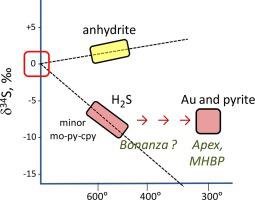当前位置:
X-MOL 学术
›
Ore Geol. Rev.
›
论文详情
Our official English website, www.x-mol.net, welcomes your feedback! (Note: you will need to create a separate account there.)
Mineralogy and Sulfur Isotope Geochemistry of Polymetallic, Porphyry-Epithermal Mineralization Peripheral to the Golden Sunlight Gold Mine, Montana
Ore Geology Reviews ( IF 3.3 ) Pub Date : 2020-11-01 , DOI: 10.1016/j.oregeorev.2020.103797 Christopher H. Gammons , Hamadou Gnanou , David Odt , Simon R. Poulson
Ore Geology Reviews ( IF 3.3 ) Pub Date : 2020-11-01 , DOI: 10.1016/j.oregeorev.2020.103797 Christopher H. Gammons , Hamadou Gnanou , David Odt , Simon R. Poulson

|
Abstract The Golden Sunlight mine, located 50 km east of the famous Butte porphyry/lode deposit, is the largest gold mine in Montana, and has produced over 3.6 M oz of gold in its 36-year history. Most of this gold has come from the Mineral Hill breccia pipe (MHBP), a west plunging, cylindrical body of brecciated latite porphyry and siliciclastic sedimentary rocks of the Mesoproterozoic Belt Supergroup. This paper focuses on four areas of mineralization outside the MHBP termed the Apex, Bonanza, North Pit, and 102/Sunlight zones. The Apex and 102/Sunlight areas consist of auriferous, pyrite-rich veins cutting Precambrian sediments and the Cambrian Flathead Quartzite, whereas the Bonanza and North Pit areas are polymetallic Mo-Cu-Ag-Au prospects hosted in latite porphyry and Belt sediments. Recent dating (40Ar/39Ar of igneous biotite) shows the porphyry at Bonanza was emplaced at 78 ± 1 Ma, which is several m.y. younger than the porphyry associated with the MHBP (81.9 ± 1.9 Ma, zircon U/Pb), and several m.y. older than the main phase of the Boulder Batholith that hosts the Butte deposit. Overall, the ore and gangue mineral assemblages in the peripheral deposits are similar to those described previously for the MHBP deposit. Pyrite, locally As-rich, is abundant in all settings, with varying amounts of galena, sphalerite, chalcopyrite, bornite, molybdenite (at Bonanza), tetrahedrite-tennantite, and traces of pearceite, tetradymite, aikinite, calaverite, petzite, goldfieldite, buckhornite, gold and electrum. Gangue minerals include quartz, carbonates (Fe-dolomite, siderite, magnesite), barite, anhydrite, adularia, and alumino-phosphate sulfate (APS) minerals. Spectral analysis indicates that some of the adularia is ammonium rich, i.e., buddingtonite. Values of δ34S for sulfide minerals from the peripheral deposits overlap with values obtained by previous workers from the MHBP. The bulk of the analyses (including all samples from the porphyry-hosted Bonanza deposit) have δ34S values between −12 and −4‰, with a tail to heavier values >+5‰. It is postulated that most of the lighter S was introduced into the district by late Cretaceous magmatic/hydrothermal fluids, whereas the heavier S is attributed to sedimentary pyrite in the Precambrian Greyson and LaHood formations. A weak negative correlation exists between gold grade and the δ34S of associated pyrite: all samples in this study that contain >0.1 oz/ton Au have δ34S reduced S.
中文翻译:

蒙大拿州金日光金矿多金属斑岩-浅成热成矿周边的矿物学和硫同位素地球化学
摘要 Golden Sunlight 矿位于著名的比尤特斑岩/矿床以东 50 公里处,是蒙大拿州最大的金矿,在其 36 年的历史中生产了超过 3.6 M 盎司的黄金。这些黄金的大部分来自 Mineral Hill 角砾岩管 (MHBP),这是一种向西倾斜的圆柱体,由中元古代带超群的角砾状拉岩斑岩和硅质碎屑沉积岩组成。本文重点介绍 MHBP 以外的四个矿化区域,称为 Apex、Bonanza、North Pit 和 102/Sunlight 带。Apex 和 102/Sunlight 区由切割前寒武纪沉积物和寒武纪平头石英岩的含金、富含黄铁矿的矿脉组成,而 Bonanza 和 North Pit 区是多金属 Mo-Cu-Ag-Au 勘探区,存在于红白斑岩和带沉积物中。最近的测年(火成岩黑云母的 40Ar/39Ar)显示,Bonanza 斑岩位于 78±1 Ma,比与 MHBP 相关的斑岩(81.9±1.9 Ma,锆石 U/Pb)小几我,还有几我比承载 Butte 矿床的 Boulder Batholith 的主要阶段更古老。总体而言,外围矿床中的矿石和脉石矿物组合与先前描述的 MHBP 矿床相似。当地富含 As 的黄铁矿在所有环境中都很丰富,含有不同数量的方铅矿、闪锌矿、黄铜矿、斑铜矿、辉钼矿(在富矿区)、四面体-铁锰矿,以及微量的珠光体、四晶辉石、铝锌矿、钙铝榴石、磷锌矿、金铁矿、沙黄石、黄金和金银矿。脉石矿物包括石英、碳酸盐(Fe-白云石、菱铁矿、菱镁矿)、重晶石、硬石膏、硬泥、和铝磷酸盐硫酸盐 (APS) 矿物。光谱分析表明,一些杜鹃花富含铵盐,即白丁矿。来自外围矿床的硫化物矿物的 δ34S 值与先前工作人员从 MHBP 获得的值重叠。大部分分析(包括来自斑岩型富矿矿床的所有样品)的 δ34S 值在 -12 到 -4‰ 之间,尾端到更重的值 >+5‰。据推测,大部分较轻的 S 是由晚白垩世岩浆/热液流体引入该地区的,而较重的 S 则归因于前寒武纪 Greyson 和 LaHood 地层中的沉积黄铁矿。金品位与伴生黄铁矿的 δ34S 之间存在弱负相关:本研究中所有含有 >0.1 盎司/吨金的样品都具有 δ34S 还原 S。光谱分析表明,一些杜鹃花富含铵盐,即白丁矿。来自外围矿床的硫化物矿物的 δ34S 值与先前工作人员从 MHBP 获得的值重叠。大部分分析(包括来自斑岩型富矿矿床的所有样品)的 δ34S 值在 -12 到 -4‰ 之间,尾端到更重的值 >+5‰。据推测,大部分较轻的 S 是由晚白垩世岩浆/热液流体引入该地区的,而较重的 S 则归因于前寒武纪 Greyson 和 LaHood 地层中的沉积黄铁矿。金品位与伴生黄铁矿的 δ34S 之间存在弱负相关:本研究中所有含有 >0.1 盎司/吨金的样品都具有 δ34S 还原 S。光谱分析表明,一些杜鹃花富含铵盐,即白丁矿。来自外围矿床的硫化物矿物的 δ34S 值与先前工作人员从 MHBP 获得的值重叠。大部分分析(包括来自斑岩型富矿矿床的所有样品)的 δ34S 值在 -12 到 -4‰ 之间,尾端到更重的值 >+5‰。据推测,大部分较轻的 S 是由晚白垩世岩浆/热液流体引入该地区的,而较重的 S 则归因于前寒武纪 Greyson 和 LaHood 地层中的沉积黄铁矿。金品位与伴生黄铁矿的 δ34S 之间存在弱负相关:本研究中所有含有 >0.1 盎司/吨金的样品都具有 δ34S 还原 S。
更新日期:2020-11-01
中文翻译:

蒙大拿州金日光金矿多金属斑岩-浅成热成矿周边的矿物学和硫同位素地球化学
摘要 Golden Sunlight 矿位于著名的比尤特斑岩/矿床以东 50 公里处,是蒙大拿州最大的金矿,在其 36 年的历史中生产了超过 3.6 M 盎司的黄金。这些黄金的大部分来自 Mineral Hill 角砾岩管 (MHBP),这是一种向西倾斜的圆柱体,由中元古代带超群的角砾状拉岩斑岩和硅质碎屑沉积岩组成。本文重点介绍 MHBP 以外的四个矿化区域,称为 Apex、Bonanza、North Pit 和 102/Sunlight 带。Apex 和 102/Sunlight 区由切割前寒武纪沉积物和寒武纪平头石英岩的含金、富含黄铁矿的矿脉组成,而 Bonanza 和 North Pit 区是多金属 Mo-Cu-Ag-Au 勘探区,存在于红白斑岩和带沉积物中。最近的测年(火成岩黑云母的 40Ar/39Ar)显示,Bonanza 斑岩位于 78±1 Ma,比与 MHBP 相关的斑岩(81.9±1.9 Ma,锆石 U/Pb)小几我,还有几我比承载 Butte 矿床的 Boulder Batholith 的主要阶段更古老。总体而言,外围矿床中的矿石和脉石矿物组合与先前描述的 MHBP 矿床相似。当地富含 As 的黄铁矿在所有环境中都很丰富,含有不同数量的方铅矿、闪锌矿、黄铜矿、斑铜矿、辉钼矿(在富矿区)、四面体-铁锰矿,以及微量的珠光体、四晶辉石、铝锌矿、钙铝榴石、磷锌矿、金铁矿、沙黄石、黄金和金银矿。脉石矿物包括石英、碳酸盐(Fe-白云石、菱铁矿、菱镁矿)、重晶石、硬石膏、硬泥、和铝磷酸盐硫酸盐 (APS) 矿物。光谱分析表明,一些杜鹃花富含铵盐,即白丁矿。来自外围矿床的硫化物矿物的 δ34S 值与先前工作人员从 MHBP 获得的值重叠。大部分分析(包括来自斑岩型富矿矿床的所有样品)的 δ34S 值在 -12 到 -4‰ 之间,尾端到更重的值 >+5‰。据推测,大部分较轻的 S 是由晚白垩世岩浆/热液流体引入该地区的,而较重的 S 则归因于前寒武纪 Greyson 和 LaHood 地层中的沉积黄铁矿。金品位与伴生黄铁矿的 δ34S 之间存在弱负相关:本研究中所有含有 >0.1 盎司/吨金的样品都具有 δ34S 还原 S。光谱分析表明,一些杜鹃花富含铵盐,即白丁矿。来自外围矿床的硫化物矿物的 δ34S 值与先前工作人员从 MHBP 获得的值重叠。大部分分析(包括来自斑岩型富矿矿床的所有样品)的 δ34S 值在 -12 到 -4‰ 之间,尾端到更重的值 >+5‰。据推测,大部分较轻的 S 是由晚白垩世岩浆/热液流体引入该地区的,而较重的 S 则归因于前寒武纪 Greyson 和 LaHood 地层中的沉积黄铁矿。金品位与伴生黄铁矿的 δ34S 之间存在弱负相关:本研究中所有含有 >0.1 盎司/吨金的样品都具有 δ34S 还原 S。光谱分析表明,一些杜鹃花富含铵盐,即白丁矿。来自外围矿床的硫化物矿物的 δ34S 值与先前工作人员从 MHBP 获得的值重叠。大部分分析(包括来自斑岩型富矿矿床的所有样品)的 δ34S 值在 -12 到 -4‰ 之间,尾端到更重的值 >+5‰。据推测,大部分较轻的 S 是由晚白垩世岩浆/热液流体引入该地区的,而较重的 S 则归因于前寒武纪 Greyson 和 LaHood 地层中的沉积黄铁矿。金品位与伴生黄铁矿的 δ34S 之间存在弱负相关:本研究中所有含有 >0.1 盎司/吨金的样品都具有 δ34S 还原 S。


























 京公网安备 11010802027423号
京公网安备 11010802027423号